
About UsThe Numismatic Bibliomania Society is a non-profit organization promoting numismatic literature. For more information please see our web site at coinbooks.org SubscriptionsThose wishing to become new E-Sylum subscribers (or wishing to Unsubscribe) can go to the following web page link MembershipThere is a membership application available on the web site Membership Application To join, print the application and return it with your check to the address printed on the application. Membership is only $15 to addresses in the U.S., $20 for First Class mail, and $25 elsewhere. For those without web access, write to: David M. Sundman, Secretary/TreasurerNumismatic Bibliomania Society AsylumFor Asylum mailing address changes and other membership questions, contact David at this email address: dsundman@LittletonCoin.com SubmissionsTo submit items for publication in The E-Sylum, just Reply to this message, or write to the Editor at this address: whomren@coinlibrary.com BUY THE BOOK BEFORE THE COINYou won't regret it! |
- WAYNE'S WORDS: THE E-SYLUM MARCH 6, 2011
- GORDON FROST 1935 - 2011
- OTHER HOBBY LOSSES: MARIE JONES AND BILL SNIDER
- NEW BOOK: 2012 GUIDE BOOK OF UNITED STATES COINS
- NEW BOOK: WORLD PAPER MONEY MODERN ISSUES, 17TH EDITION
- NEW BOOK: THE ENCYCLOPEDIA OF LIBYAN BANKNOTES
- NEW BOOK: A 16TH CENTURY HOARD FROM BULGARIA
- BOOK REVIEW: OTTOMAN EMPIRE COINS 1687 - 1839
- LITERATURE ON WORLD COINS CIRCULATING IN EARLY AMERICA
- WHITMAN PUBLISHING SEEKS CANADIAN COIN IMAGES
- FORMER ANA EXECUTIVE DIRECTOR PAYS ORGANIZATION
- VOCABULARY WORD: WIRE EDGE
- MORE ON THAT BEP INTAGLIO TEST PLATE
- THE GREAT FOOD STAMP ROBBERIES
- ON FLUORESCENT LIGHTS AND UV PROTECTION
- MORE ON STEVE TANENBAUM
- WAS PAUL SEITZ THOMAS ELDER'S SON-IN-LAW?
- PRESIDENT CLINTON VIETNAM VISIT CHALLENGE COIN
- INTERVIEW WITH CHRIS WEBB OF DIX NOONAN WEBB
- ARTICLE PROFILES PRINCETON CURATOR ALAN STAHL
- GADDAFI'S LIBYA BANKNOTE ORDER FOILED BY PRINTER DE LA RUE
- THOUGHTS ON THE BRITISH MUSEUM
- MEDALS FOR THE 1897-1898 OVERLAND RELIEF EXPEDITION
- NOTES FROM E-SYLUM READERS: MARCH 6, 2011
- ARTICLE DISCUSSES THAMES RIVER NUMISMATIC FINDS
- SHROPSHIRE MEDIEVAL COIN FIND DECLARED TREASURE
- HOW MUCH FORGED MONEY IS IN CIRCULATION IN THE UK?
- BRITISH STUDENT DESIGNS 2011 NETHERLANDS TWO EURO COIN
- DICKIN MEDAL PROPOSED FOR TALIBAN-FIGHTING DOG THEO
- VIDEO: VANCOUVER 2010 WINTER OLYMPICS MEDAL DISPLAY
- FEATURED WEB PAGE: A HAND-ENGRAVED GOLD DOLLAR PATTERN
WAYNE'S WORDS: THE E-SYLUM MARCH 6, 2011

Among our new subscribers this week is Brett Martin. Welcome aboard! We now have 1,407 email subscribers, plus 116 followers on Facebook, including Nancy Wilson and Rick Reynolds.
This week we open with more sad news of deaths in the hobby. On a brighter note for bibliophiles, we have notices of FOUR new numismatic books and a review of one mentioned last week.
Other topics include the literature on world coins circulating in colonial America, the effects of fluorescent lighting on books, and profiles of Chris Webb and Alan Stahl.
To learn more about Libyan banknotes, Gaddafi's foiled banknote order, wire edges, the Great Food Stamp Robberies, and the 1897-1898 Overland Relief Expedition and 438 reindeer, read on. Have a great week, everyone!
Wayne Homren
Numismatic Bibliomania Society
GORDON FROST 1935 - 2011
I got the news via Ray Williams on the Yahoo Colonial Coins group. Below are some comments from Ray and Roger Siboni from Yahoo, followed by comments from other E-Sylum readers. Thanks to George Cuhaj for both photos of Gordon. -Editor

Ray Williams wrote:
Although Gordon Frost was not a C4 Member, he was a numismatic literature dealer and many may have built their libraries through purchases from him. While manning the C4 table at ANA, he and I must have talked for 1 1/2 hours (in between helping people that came to the table).
Roger Siboni wrote:
Gordon was the go-to guy for anything American Numismatic Society. He helped me assemble my first set of AJNs. He also had an encyclopedic knowledge about just about every area of numismatics. An active member of the ANS, NY Numismatic Club, a few other clubs and a wry wit.
He will be missed.........So Joe Lasser, Steve Tanenbaum and Gordon Frost. Let's call it three and hope there is no more bad news on the horizon.
George Cuhaj writes:
Gordon Frost was modest and unassuming, almost to a fault. In life he was a trainer, and he put those those techniques of good management and planning to use his hobby - books and numismatics. When he was asked by executives to improve something, advice was given; when executives made really stupid decisions on their own he was able to shrug it off as he had nothing to do with it (the decision, at least). Often he would just exclaim "I just do not understand how these people..."
We probably met at the American Numismatic Society public meetings where he was a regular attendee at the old building at Audubon Terrace, then frequently at educational programs during the New York City shows and then meetings of the Bronx Coin Club (which meets in Manhattan), the New York Numismatic Club or the Westchester Coin Club.
When Gordon got to know what you were interested in, he would often make connections and a book you did not know about, but he knew your would want would come your way. One learned early on that Gordon did not haggle, the price was the price. You took it, as Gordon was confident he would find another home for it. He found me books in all my fields of collecting, scouting, subway, railroads and the Catholic Church.
I could always count on Gordon for a friendly greeting and good conversation on a variety of topics. He had a variety of interests and made those topics an education to you in an interesting way.
Gordon always was in good humor and enjoyed the slight paradoxes of life.
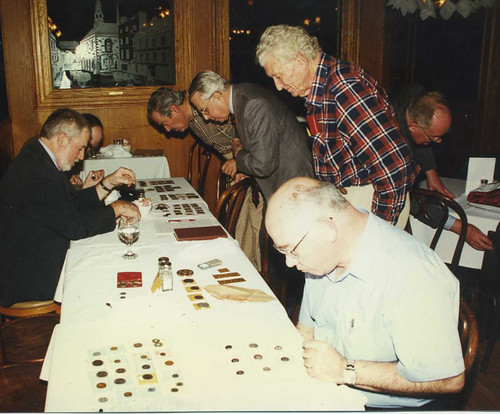
Gordon Frost(front) at the Bronx Coin Club.
George Frederick Kolbe writes:
F. Gordon Frost (always known as Gordon though we shared a common name), was an integral part of the American numismatic literature scene for more years than I care to remember. I would have first met Gordon in the late 1970s, perhaps at an obscure east coast numismatic literature auction that we knew about but hoped that no one else did. Or, more likely perhaps, we first met at a New York International Numismatic Convention. I had a bourse table there for a few years before the series of Kolbe/Spink New York auction sales began in December 1982.
Gordon almost always attended these sales in person. While far more often the best man rather than the groom, over the years Gordon bought some wonderful books there. I would guess that most ended up on his private shelves rather than being offered for sale in his many informal fixed price lists sent to a select clientele. Gordon, you see, loved books, particularly those of a numismatic persuasion.
In the later 1980s, he and his lovely spouse Rosalie trekked up the mountain and spent an enjoyable afternoon with Linda and me in Crestline. Several years later, I visited with the Frosts at their then newly-built home in Forest Hills. During the construction process, Gordon moved a whole lot of dirt and, in effect, carved out an underground bunker; a book bunker, if you will. Then graced with thousands (tens of thousands?) of numismatic publications covering the numismatic spectrum, I gathered from conversations with Gordon over the ensuing years that this was just a beginning.
Gordon was, like so many of us, a unique, unusual man. He was an instrumental, if perhaps under-appreciated, force in the numismatic literature field, both as a bibliopole and a bibliophile. He will be missed.
Myron Xenos writes:
Gordie was, for years, putting together a bibliography of treasure-related works. The last time I saw him, he said he was up to 800 listings. He was a dedicated bibliophile.
Joel Orosz writes:
I knew Gordon only slightly, and beyond a superficial knowledge of his interest in numismatic literature related to shipwrecks and treasure, I know little about his collecting interests. I enjoyed his sense of humor and his never-failing wry grin, and I will miss him. 2011 is shaping up to be a year in which we lose too many stalwarts of our hobby -- as Joan Rivers would say, "make it stop!"
OTHER HOBBY LOSSES: MARIE JONES AND BILL SNIDER
Marie Jones
Myron Xenos writes:
Some E-Sylum subscribers who specialize in paper may have known Marie Jones, wife of Harry Jones, paper money dealer from Cleveland. She passed away suddenly at their winter home in Stuart, Florida, on February 23d. Many people will remember her sitting at Harry's table at many shows. Those of us who knew her will miss her cheery disposition.
Bill Snider
John and Nancy Wilson write:
We were notified Thursday by our good friend Mark Lighterman, who received notification from another person regarding the passing of Bill Snider. What a great loss for all of us. Bill was one of the best known collectors of wooden money that ever lived. He was President of the Dedicated Wooden Money Club and served them in some capacity for many years. His life evolved around wooden money and his many friends. He traveled from one coast to another to attend wooden money meetings or to a coin show that had tables promoting wooden money.
He was a mainstay at just about every American Numismatic Association convention that we can remember. Any larger show in the Midwest would also have Bill in attendance. He was always the first one to the wooden money meeting and the last one to leave. He always wore his shirt "I Collect Wooden Nickels." You could always find Bill at the Wooden Money table promoting the collecting of woods. He was friendly and cordial to everyone he met. His passing will leave a big void in the Wooden Money organizations he belonged to, especially the DWMC. This is a great shock to us and we will dearly miss our good friend Bill. Rest in peace Bill, as your memory will always be with us. Our sincere sympathies to his family.
THE BOOK BAZARRE
NEW BOOK: 2012 GUIDE BOOK OF UNITED STATES COINS
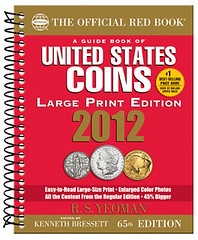 The 2012 (65th)
edition of the Guide Book of United States Coins (known to collectors as the “Red Book”) includes many new features, plus additions and updates to the book’s 1,900-plus
color photographs. A redesigned title page commemorates the annually published guide’s reaching its 65th anniversary. The new edition, debuting April 2010 in four different
formats, is available online (including at WhitmanBooks.com) and in bookstores and hobby shops nationwide.
The 2012 (65th)
edition of the Guide Book of United States Coins (known to collectors as the “Red Book”) includes many new features, plus additions and updates to the book’s 1,900-plus
color photographs. A redesigned title page commemorates the annually published guide’s reaching its 65th anniversary. The new edition, debuting April 2010 in four different
formats, is available online (including at WhitmanBooks.com) and in bookstores and hobby shops nationwide.
“Valuations in this year’s Red Book reflect the general state of the market, throughout the hobby,” said longtime editor Kenneth Bressett. “Rare coins in exceptional condition continue to hold or increase in value. Many of the more ordinary items have shown some price weakening, while most low-grade pieces remain unchanged or in some cases have gone up because of their high bullion value. Overall, there seem to be bargains to be had throughout the entire range of American coins now that prices have receded a bit from the overheated market of recent years.”
Bressett pointed to appendix C (“Bullion Values of Silver and Gold Coins”) as an indicator of today’s precious-metal trends. The 64th-edition Red Book charted silver from $8 to $22, and gold from $925 to $1,450. In the 65th edition this appendix has been doubled in size, charting silver from $16 to $43 and gold from $800 to $1,875.
Observing today’s rare-coin market, Valuations Editor Jeff Garrett said, “Important, high-quality coins continue to bring record amounts. Increased bullion prices have lifted the value of common, low-grade issues, but in general coins with average eye appeal have softened slightly due to the weak economy. While many collectors and investors focus on bullion, rare coins offer tremendous value at today’s prices.”
Research Editor Q. David Bowers, commenting on the book’s continuing popularity (more than 22 million copies have been sold since 1946), noted that “Even in the Internet age, the Red Book remains solidly the collector’s best and first choice for instant information.”
Modern coin series have been updated with new photographs, including the current Shield Reverse Lincoln cents, National Park quarters, Presidential dollars, Native American dollars, bullion coins, and commemoratives. Missing-edge-lettering errors are now mentioned among the Presidential dollars. The National Park quarters section includes a complete roster of coins to be released through 2021, listed by park and state. Older coins that have additional or updated photographs include Flying Eagle and Lincoln cents; Shield, Liberty Head, and Buffalo nickels; Draped Bust and Liberty Seated coinage; and the 1996 Olympic commemoratives.
The “Pre-Federal Issues” section covers colonial and post-colonial coins and tokens as well as Continental dollars and other early contract issues and patterns. The 65th edition continues to price these items in the expanded lower- to middle-range grades introduced in the 64th edition. “Many beginning collectors find Good and Very Good to be affordable jumping-in points for exploring these popular coins,” said Bowers, author of the Whitman Encyclopedia of Colonial and Early American Coins. “Keen-eyed collectors will notice new information like the expanded text on John Adams Bolen’s 19th-century copies of the Bar copper.”
The “Bullion” section includes updated information and photographs for the U.S. Mint’s latest issues, including the America the Beautiful™ five-ounce silver bullion coins, new First Spouse gold, and Proof platinum.
Mintage figures for all circulating coins and commemoratives have been updated as currently as possible with official data from the U.S. Mint.
The “Type-Coin Value” charts at the front of each denomination have been removed from the 65th-edition Red Book. “The higher-grade values previously covered in these charts are now covered in the Professional Edition Red Book, an advanced volume for the more experienced collector and specialist,” said Whitman publisher Dennis Tucker.
In addition to the 65th-Anniversary Red Book’s nearly 33,000 individual coin prices in up to nine grades per series, appendix D showcases the Top 250 Auction Prices for U.S. coins. “We’ve tracked auctions through early 2011,” said Garrett, who noted a jump of more than $17,000 compared to the 64th edition’s chart. “Last year’s 250-ranked coin sold for $356,500,” Garrett said. “To make it onto this year’s list, the 250-ranked coin (a 1921 double eagle) sold for $373,750.” Garrett also noted that two more individual coins broke the $1 million mark, for a total of 42.
To help guide collectors of high-grade coins and rarities, details from significant auction sales are listed throughout the Red Book’s coin charts. Coins with new auction-record listings this year include the Continental dollar, large cents, several Draped Bust and Liberty Seated series, and Liberty Head and Saint-Gaudens double eagles.
Appendix B, “Collectible Red and Blue Books,” has been expanded with more details. Coverage of recent collectible Red Books includes the 2011 Boston Numismatic Society Special Edition, currently valued at $100 in New condition.
The 129 listings in the Red Book’s numismatic bibliography include more than a dozen references published from 2008 to 2011.
About the Guide Book of United States Coins
A Guide Book of United States Coins is the world’s most popular annual retail price guide for U.S. coins, tokens, and other numismatic items. More than 22 million copies have been purchased since 1946, making it one of the best-selling nonfiction titles in the history of U.S. publishing.
For the 65th edition, more than 140 professional coin dealers, scholars, and other numismatic experts contributed their knowledge under the direction of Editor Kenneth Bressett, Valuations Editor Jeff Garrett, and Research Editor Q. David Bowers.
The 65th edition of the Red Book is available in April 2010, online and at bookstores and hobby shops nationwide. In addition to offering a Large Print Edition and several formats of the regular edition, Whitman Publishing is also taking pre-orders for the leather-bound Limited Edition (1,000 copies autographed by Bressett). For more information and to order, the Whitman web site is www.WhitmanBooks.com. The publisher is offering free shipping on every order placed online that includes a 65th-edition Red Book, through April 5.
# # #
432 pages
Full color
By R.S. Yeoman; edited by Kenneth Bressett
$14.95 spiralbound
$16.95 hardcover
$19.95 spiralbound hardcover
$29.95 Large Print Edition
$69.95 leather-bound Limited Edition (1,000 copies)
NEW BOOK: WORLD PAPER MONEY MODERN ISSUES, 17TH EDITION
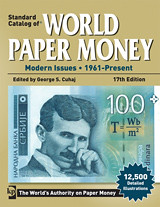 A new edition of the most
comprehensive English language world bank note guide is now available from Krause Publications.
A new edition of the most
comprehensive English language world bank note guide is now available from Krause Publications.
The Standard Catalog of World Paper Money Modern Issues, 17th edition, features bank notes issued worldwide since 1961.
- More than 19,500 variety listings
- 12,500 bank note illustrations for easily identifying notes
- Current retail prices in two grades of condition
- Numeral charts and bank note signature charts
A network of more than 80 international bank note collectors and dealers work with editor George S. Cuhaj to ensure that the Standard Catalog of World Paper Money, Modern Issues is the most comprehensive resource available for the proper identification, description and valuation of modern world bank notes.
For more information, visit: www.shopnumismaster.com/product/standard-catalog-
of-world-paper-money-modern-issues-17th/new
Editor George S. Cuhaj is a 17-year veteran of Krause Publications' Numismatic Catalog Division, where he is also the editor of the Standard Catalog of World Coins series. Cuhaj hails from New York City, where he was previously on staff with the American Numismatic Society, Stack's Rare Coins and R.M. Smythe & Co. He is a frequent instructor at the American Numismatic Association's Summer Seminars.
NEW BOOK: THE ENCYCLOPEDIA OF LIBYAN BANKNOTES
Len Harsel writes:
For those who are interested, there is a new book by Ali Mehilba on Libyan banknotes. I have not seen a copy yet but it is currently available for a short time for US$35.00. Check out the website www.AliNotes.com. Ali will be in the U.S. until end March when he should be going back to Egypt!
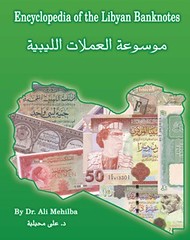 The Encyclopedia of Libyan
banknotes covers the history of paper banknotes after the Ottoman occupation in 1911 till today. Also Libya faced another occupation (UK - France - Italy) before the freedom 1951.
These currencies were used before liberation,
The Encyclopedia of Libyan
banknotes covers the history of paper banknotes after the Ottoman occupation in 1911 till today. Also Libya faced another occupation (UK - France - Italy) before the freedom 1951.
These currencies were used before liberation,
- Egypt Pound
- English Pound
- Italian Lira
- Algerian Frank
- French Franc
- British military administration currency either by Lira or English Pound
This book was published in 4 colors, in both English and Arabic languages and includes all Libyan issues to date. This book includes a lot of information important to collectors in general and to Libyan currency collectors specifically.
To get a digital pdf copy, you can purchase it here.
To get your hard copy contact the author:
Egypt: +20122137814
USA: +19094569494
AliMehilba@yahoo.com
For more information, see: www.alinotes.com/store/libyabook.php
NEW BOOK: A 16TH CENTURY HOARD FROM BULGARIA
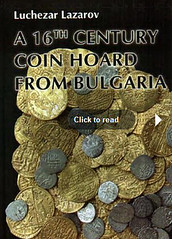 This book is about
the hoard found before 1989 on the territory of present-day northeastern Bulgaria.
This book is about
the hoard found before 1989 on the territory of present-day northeastern Bulgaria.
For more information, see: issuu.com/kaanuslu/docs/16th_century_coin_hoard_from_bulgaria
BOOK REVIEW: OTTOMAN EMPIRE COINS 1687 - 1839
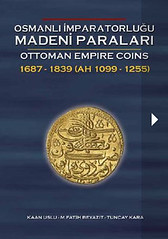 We mentioned last week the publication
of Osmanlý Ýmparatorluðu Madeni Paralarý - Ottoman Empire Coins 1687 - 1839 (AH 1099 - 1255) by Kaan Uslu, M. Fatih Beyazit, and Tuncay Kara. This work is
the second in a series of studies on Ottoman coins in which the authors are working back in history; volume 1 of the series covered the coinage of the last six sultans of the
Ottoman Empire and the years 1839 to 1918 (AH 1255 to 1336).
We mentioned last week the publication
of Osmanlý Ýmparatorluðu Madeni Paralarý - Ottoman Empire Coins 1687 - 1839 (AH 1099 - 1255) by Kaan Uslu, M. Fatih Beyazit, and Tuncay Kara. This work is
the second in a series of studies on Ottoman coins in which the authors are working back in history; volume 1 of the series covered the coinage of the last six sultans of the
Ottoman Empire and the years 1839 to 1918 (AH 1255 to 1336).
For those of us interested in the coinage of the Ottoman Empire, these books are a wonderful asset. For years Ottoman coinage references were difficult to obtain and sparse in the details of the coins. Now, for a reasonable price, you can have a full color, bilingual Turkish-English reference that covers all Ottoman coins and their details for the period of the book. The books are organized chronologically by sultan, then alphabetically by mints. All known coins for each mint are discussed, with full color pictures for nearly all the coins. The arabic spelling of each mint is included to allow the collector to easily identify where the coin originated.
The entry for each coin includes a transliteration of each face of the coin, the weight and diameter, date, engraver marks (as applicable), regnal year, rarity, as well as the KM and OC number (the OC number is from the database hosted at the authors' web site www.ottomancoins.com). To help the collector learn to better identify Ottoman coins the authors have provided multicolor line drawings of key coins with transliterations of the arabic scripts. Adding to the utility of the books is their convenient size. At roughly 9" x 6" octavo size, they easily fit inside a small bag and can be taken along to your next coin show.
To make these books available to a wider audience, they are available from the authors on eBay. As of this writing, volume 1 is $32 and volume 2 is $52. Shipping is listed at $9.50 on each auction, but the authors did combine shipping costs when I purchased my copies.
If you are looking for another Ottoman reference for your library, or you are looking for your first, you can't go wrong with these wonderful books. Volume 2 was apparently a limited run of 500, so don't delay!
To read the earlier E-Sylum article, see: NEW BOOK: OTTOMAN EMPIRE COINS 1687-1839 (www.coinbooks.org/esylum_v14n09a02.html)
I have volumes 1 and 2 of Atom's books and #3 is on the way. Atom's approach was from the first years of the Ottomans while Uslu et al worked backwards. Atom's books are also lovely books, but they are quarto and much heavier. Both series are printed on heavy paper, just that there is so much more in the bigger books.
V1 of Atom's books goes from Osman I through Selim I, and V2 is only Suleyman the Magnificent's coins. Atom's books also have the pictures of the coins enlarged i.e., not at actual size, so they show more detail but you need that extra step of measuring the coin to see if it is what you think it is.
To read the earlier E-Sylum article, see: NEW BOOK: HISTORY OF OTTOMAN COINS (VOLUME II) BY DAMALI (www.coinbooks.org/esylum_v13n26a04.html)
NEW LARGE-PRINT RED BOOK!
LITERATURE ON WORLD COINS CIRCULATING IN EARLY AMERICA
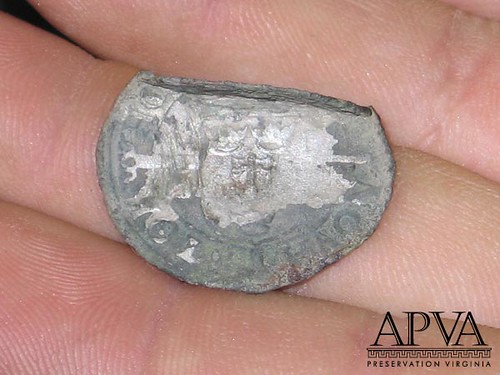
17th century Swedish silver coin found at colonial Jamestown
The inquiry I received this morning had to do with books. I like questions about books. An educated customer is our best customer. The collector has an interest in the foreign coins that circulated in early America, from colonial times until the end of foreign coins’ legal status in the United States in 1857, and was curious to know what kind of published literature there was on the subject. Admittedly, there’s not much out there. In fact, it’s a topic that deserves its own book and I’d love to write it someday.
The proportion of foreign coins in circulation in the U.S. was substantial until the Civil War. Luckily, the types are well documented �" but the information is scattered throughout a variety of obscure primary sources. The best are U.S. Mint reports and other official publications. Books like 1850’s A Manual of Gold and Silver Coins of All Nations by Eckfeldt and Dubois not only offered insight into what came into the Mint in assays, but summarized the various Congressional acts that described the values of the common coins then found in circulations. The same information can be found in American State Papers, offprinted Mint reports, or other government publications. Adding to the broad strokes Congress took to identify and value foreign coins then in commerce, other contemporary literature �" almanacs, magazines, newspapers, even fictions �" can complete the picture of coins in circulations.
In modern times, the various post-1793 Mint acts that regulated foreign coins were published with illustrations (and values) of the relevant types as America’s Foreign Coins by Raphael Solomon and Oscar Schilke. Now out of print, the book is useful, though not exactly chock-full of facts. It is easily found among the inventories of numismatic literature dealers. Unfortunately, the Schilke-Solomon book only covers laws (and types) after the foundation of the U.S. Mint.
The wide variety of foreign coins circulating in colonial and Confederation-era America is ably covered in Phillip Mossman’s Money of the American Colonies and Confederation. Issued at a price tag near $100, some phone calls to numismatic booksellers may well reveal a lower price tag. Go buy it. It’s academic, it has graphs and charts, and the footnotes sometimes take up more of the page than the text. It’s brilliant. If I could only take one book to a desert island and still hope to still write columns on colonial coins, I’m not sure I wouldn’t take Mossman instead of Crosby.
Using contemporary references and archaeological information, Mossman paints an accurate picture of the mess of domestic and foreign types in early America. The archaeological evidence is especially important, since the finds of coins here and there in small digs are published one at a time in obscure non-numismatic publications. Rarely do they see numismatic sunlight.
Crosby’s 1875 The Early Coins of America is useful in the same way Schilke-Solomon is, aside from the latter volume's pictures and quaint 60’s-era pricing, which is to say it has the original text of laws that regulate the value of foreign coins in circulation. It’s often a dry read, and the terms used by colonial legislatures were not numismatically precise and require interpretation, but the facts are often best found in those legal papers.
The often-overlooked monograph by Joe Lasser entitled The Coins of Colonial America is a treasure trove, despite its brevity. Illustrated by some of the mgnificent pieces he gave Colonial Williamsburg, the book shows the wide variety of world trade coins �" silver and gold �" that found their way to American shores. In an appendix, many of the coins that have been archaeologically recovered at Williamsburg also make an appearance. It’s the textbook Erik Goldstein and I use every summer in our ANA Summer Seminar class.
To read the complete article, see: The Literature On World Coins Circulating in
Early America: An Inquiry (kraljeblog.blogspot.com/2011/03/literature-on-
world-coins-circulating.html)
WHITMAN PUBLISHING SEEKS CANADIAN COIN IMAGES
Whitman is working on a book about Canadian coins, and our image library is missing some type coins and varieties. Most of what we need are modern Canadian circulating issues, like the 1992 provincial quarters, the various recent portraits of Queen Elizabeth II on all denominations, and the like. We also need images of some earlier coins --- about 30 various New Brunswick, Newfoundland, Nova Scotia, Prince Edward Island, and Province of Canada pieces.
I can email a detailed list to potential contributors. Everyone whose images we use will be credited in the book’s acknowledgments. I’m looking for high-resolution scans or nice, clear, large digital photos. Alternately, the coins themselves can be shipped to Whitman Publishing in Atlanta and we’ll photograph and return them.
My email address, for anyone who wants to participate in this project, is dennis.tucker@whitmanbooks.com. .
FORMER ANA EXECUTIVE DIRECTOR PAYS ORGANIZATION
A tangled, nearly six-year legal saga has ended with an undisclosed financial settlement between the American Numismatic Association and Christopher Cipoletti, the ANA’s former executive director and general counsel, the organization announced Thursday.
The agreement brings to an end multiple lawsuits that began in July 2005, when Cipoletti sued the Colorado Springs-based nonprofit, former employees and a former vendor on various complaints, including civil theft of business property. That lawsuit was resolved “to the mutual satisfaction of all parties,” according to the ANA, in July 2008.
The ANA’s current executive director Larry Shepherd had said the lawsuit cost the organization for coin collectors $1.3 million in expenses.
The association’s board fired Cipoletti on Oct. 15, 2007, claiming his conduct constituted a breach of fiduciary duty. The ANA then sued Cipoletti for malpractice and other professional misconduct, including negligence, breach of fiduciary duty and civil theft; it was that lawsuit that was just settled.
The out-of-court settlement, which involves Cipoletti paying a confidential sum of money to the ANA, comes on the heels of a settlement reached in November in another lawsuit �" this one involving the ANA and its former law firm and lawyer from Denver. That case was filed against the ANA for nonpayment of more than $400,000 in legal fees accumulated in defending against the original lawsuit Cipoletti filed.
Cipoletti also filed an arbitration case seeking nearly $214,000 in accrued wages and benefits after he was terminated. A 15-page report the arbitrator issued in May 2009 ruled in favor of the ANA, saying Cipoletti not only was not entitled to further compensation but also intentionally stole more than $9,000 from the organization during his employment and breached his fiduciary obligations and duties of loyalty.
A 4th Judicial District judge then ordered Cipoletti to pay $53,550.26 to the ANA to cover the expenses of the arbitration. Cipoletti appealed to the Colorado Court of Appeals.
Although the ANA declined to disclose the terms of the settlement, Shepherd said the settlement “resolves all pending lawsuits,” indicating that Cipoletti’s court-ordered payment to the ANA for the arbitration expenses stands.
“It’s a great relief to know that we can now dedicate all of our resources and energies to our core mission: numismatics,” Shepherd said.
To read the complete article, see: Ex-numismatics executive agrees to pay former employer (www.gazette.com/articles/former-113904-cipoletti-settlement.html)
Background
From June 2002 through October 2007, Mr. Cipoletti was employed as ANA's executive director and general counsel. After ANA terminated Mr. Cipoletti, he filed a demand for arbitration as required by his June 2002 employment agreement, claiming that ANA had breached the employment agreement. ANA denied any breach.
The dispute at arbitration was whether ANA had cause to terminate Mr. Cipoletti. After Mr. Cipoletti presented his case to the arbitrator, ANA moved to dismiss based on after-acquired evidence that Mr. Cipoletti had committed wrongdoing while employed by ANA. In that motion, ANA also requested attorney fees and arbitration costs pursuant to a purported fee- and cost-shifting provision in the employment agreement.
To read the complete ruling, see: AMERICAN NUMISMATIC ASSOCIATION v.
CIPOLETTI (www.leagle.com/xmlResult.aspx?xmldoc=In%20COCO%2020110303056.xml
&docbase=CSLWAR3-2007-CURR)
VOCABULARY WORD: WIRE EDGE
When there is more metal in a blank -- more mass than the die chamber allows (the die chamber is that area between two dies in the extended position and the collar) -- the metal must flow out somewhere. Pressmen hate this. Unless, of course, they are using open face dies (which do not use the restraing collar) and the excess metal flows out between the dies, as intended.
The excess metal is a burr or fin. In metalworking this is called flash, and it is easily removed by trimming. The flash formed on large round medals, as those struck with open face dies (called box dies in England), for example, is simply turned on a lathe and trimmed off.
For pieces struck in a coining press the only place for that excess metal to flow out is between a die and the collar. On a struck coin or medal this forms that burr or fin at the rim-edge juncture -- at the exact point where the edge meets the rim. That is a wire edge. It is also called a knife edge, or even a knife rim.
Coining press operators really hate this! They first try to readjust the amount of impression -- lower the pressure. They hope they can still get a fully struck up piece with surface metal filling every die cavity, even filling all the high points on that struck piece, with a single blow at the lower pressure.
If continued striking at the lower pressure still results in a wire edge, with any extraneous extrusion, they step up their swearing. It may require to replace the blanks of a thinner gauge. Continued use of oversize blanks or too strong an impression resulting in wire edge strikes will cause excessive wear to both the collar and the edges of dies. Dies are usually the first to break. Where? At the edge, creating what pressmen call a rim diebreak and what collectors call a cud on a struck piece.
Blanks are upset before being fed into a coining press. The upsetting process thickens the edge somewhat so it requires less metal that needs to be moved around when the piece is struck. For the usual business strikes, say coins intended for circulation, such a sharp point at that rim-edge juncture is not required. For striking proof surface coins and medals, however, it is intended to make that point at the rim-edge juncture as full as possible producing a 90-degree angle. Thus wire edges are more likely to be found on proof surface coins and medals than business strikes.
The private Canadian firm of Lombardo struck proof surface medals with wire edges so frequently it became a diagnostic of their production. This was probably because they were using old coining equipment (as with worn collars) and high pressure to get a fully struck piece. They ultimately solved that production anomaly by adding another step -- they trimmed off the wire edge by placing the proof piece in a lathe and milled off the wire edge down to the rim.
MORE ON THAT BEP INTAGLIO TEST PLATE
 My name is Craig Covert and I worked
with Neil Shafer on the article published by Banknote Reporter magazine February 2011..."Intaglio Test Plate Surfaces at FUN"
My name is Craig Covert and I worked
with Neil Shafer on the article published by Banknote Reporter magazine February 2011..."Intaglio Test Plate Surfaces at FUN"
I would like to clarify your article recently published in The E-Sylum.
The title of the article AN INTAGLIO FOOD STAMP TEST PLATE is inaccurate as the INTAGLIO TEST PLATE was originally designed to test US currency ($1 FRN's) not food stamps.
The intaglio plate had nothing to do with production of food stamps.
If you carefully read the article, you will notice that the only thing that has anything to do with "INTAGLIO FOOD STAMPS" is the basic layout of the engraved die...the "artwork"

The testing of the BEP Hamilton Intaglio Research Press/ Intaglio Plate required an image for testing...The BEP approved an image for testing US currency produced on a web press, not food stamps, and had nothing to do with food stamps with the exception of the engraving "artwork"...
Additionally, the food stamp image used is inaccurate as well.. I included a link to some images of the correct TEST PLATE.
To read the earlier E-Sylum article, see: MORE ON THAT BEP INTAGLIO TEST PLATE (www.coinbooks.org/esylum_v14n09a09.html)
THE GREAT FOOD STAMP ROBBERIES
A ROBBER ALMOST SCORES A SET OF DIES FOR FOOD STAMPS IN 1978
The BEP did not print Food Stamps when I arrived in April 1979, although I am certain that the powers that were at that time would have expected and wanted to. However, the BEP
did design and engrave the plates.
In 1978, a courier, a plain clothes security officer, was directed to take a set of newly engraved plates to New York City--the Bronx, to American Banknote headquarters. The courier was armed. He took the train from Washington, D.C. to New York City and the subway to the Bronx.
As he was exiting the subway station in that perilous area surrounding ABN, a fellow stuck a knife in his back and demanded money. The courier prudently handed over his wallet and the robber escaped. The courier protected the Food Stamp dies and kept his gun holstered.
THE GREAT FOOD STAMP HEIST AT BANKNOTE COMPANY IN PHILADELPHIA C. 1983
I received a call to meet with Treasury Secretary Regan and Secret Service Director John Simpson. Both John and I assumed it concerned the recent heist of food stamps from the
loading dock of the security printer in Philadelphia. The Secretary had read a news article about the theft and wanted background.
I explained the BEP's part in the design and engraving. John said that his agency had no jurisdiction over the theft. The Secretary asked us to speculate on the street value of the theft. I have forgotten the amount stolen from either the loading dock or the loaded truck at the loading dock. John thought perhaps 35% of face value. I wondered if the notes would be shipped to Puerto Rico. John averred that such was possible and that would raise the street value to 50% of face. Secretary Regan was nonplused.
To read the earlier E-Sylum article, see: MORE ON THAT BEP INTAGLIO TEST PLATE (www.coinbooks.org/esylum_v14n09a09.html)
ON FLUORESCENT LIGHTS AND UV PROTECTION
Joel Orosz writes:
Old-style tube fluorescent lights emit damaging levels of ultraviolet radiation, which will discolor paper. I do not know whether the newer compact fluorescent bulbs emit UV, or if so, at what level, but it would seem likely that they emit at least some UV radiation.
Jon Radel writes:
I believe the short answer is: Yes, fluorescent lights put out more ultraviolet (UV) light than incandescent lights, but if you've got windows in your library, even indirect sunlight is probably doing considerably more damage than fluorescent lights will ever do. Particularly if you turn the lights off when you don't need them.
To be a bit more precise, GE likes to reference a NEMA (National Electrical Manufacturers Association) study that found the UV exposure at typical office fluorescent light levels for 8 hours was the same as slightly over a minute of sunlight on a clear July day in Washington DC.
Since this is a problem that's been around for a long time (particularly the issue with sunlight), and not everyone likes living in a cave with black-out paint on the all the windows, there are products for filtering out UV light. As an example, if you go to www.universityproducts.com and search for "light filters" you'll find UV filters for full-sized fluorescent light tubes; I have no idea how well they'd trim to fit compact bulbs but I suspect it's not very practical. If you search for "uv filter" you'll find film to be applied to windows, which blocks 95%+ of the UV light. It looks like it may be the same stuff I can get for slightly less money at my local Home Depot.
I'll also note that another up-and-coming replacement for incandescent bulbs are lights based on using multiple super-bright LEDs. I understand that these can have very low UV output, though the details appear to depend on the technology used to make the "white" LEDs.
P.S. While I usually find spelling flames a waste of time, I'll note that while "florescent" passes the spellchecker test, it actually means something quite different than "fluorescent" and leads to musings about verdant plants living under spectrum-balanced fluorescent lights--but that may just be me.
Chris Salmon writes:
A few thoughts regarding the question of fluorescent lights, ultraviolet radiation, and damage to books:
I have been extremely concerned about fluorescent lighting and fading of various collectibles, including books, because uncovered fluorescent lights are a source of UVA (ultraviolet light of a certain spectrum). Fortunately, I've learned that covered or filtered fluorescent bulbs should help block much of the emitted UV light.
When considering the care of rare books and other collectibles susceptible to damage from fading and photoaging (furniture, photographs, prints, documents, rugs, etc.) it's useful to bear in mind that UV light only accounts for about 40% of fading. Heat accounts for about 25%, visible light about 25%, and miscellaneous other factors (including humidity) about 10%. A cool, dark environment with a low relative humidity is ideal. The best range of temperatures is 60-70 degrees.
Controlled humidity is extremely helpful. Relative humidity of 45-60% has been recommended, although the track record of low humidity in Egypt in preserving fourth century papyri--and even older mummies--is obviously extremely impressive. Effective preservation of mummies along the arid coastal plain of Peru is also well documented.
Keep vulnerable collectibles such as artwork and books out of direct sunlight. Of course, window treatments (opaque curtains or shutters) are helpful. Window film (e.g., from 3M or Huper Optik) can block up to 99.9% of UV light, much heat, and significantly reduce electric bills. Some films are designed to protect against shattering, and can reduce glare on computer monitors/laptops or TVs. I've done some recent research on film and am having it placed on all of the windows of my Arizona home. Even with the film in place I will keep fragile objects out of direct sunlight and limit artificial light to a reasonable minimum in sensitive areas. I carefully control temperature year round. High humidity is not an issue for us here!
To read the earlier E-Sylum article, see: QUERY: IS FLORESCENT LIGHTING HARMFUL TO BOOKS? (www.coinbooks.org/esylum_v14n09a11.html)
MORE ON STEVE TANENBAUM
Dave Wnuck of Coin Rarities Online writes:
We just posted an article on the late token & medal dealer Steve Tanenbaum on our website.
It would be great if we could find a photo or two of him to help illustrate that article. My guess is many collectors who may not know his name would instantly recognize him in a photo, as he was a fixture at major shows for many years.
Can you help, or can you mobilize the legendary ranks of the E-Sylum membership to assist? We would credit the owner of the image(s), of course.
To read the complete article, see: In Memory of My Friend Steve
Tanenbaum (www.coinraritiesonline.com/index.php?page=mkt
&PHPSESSID=gdphg0l528qff85a6p9s7ofec0)
To read the earlier E-Sylum article, see: MORE ON STEVE TANENBAUM (www.coinbooks.org/esylum_v14n09a07.html)
WAS PAUL SEITZ THOMAS ELDER'S SON-IN-LAW?
Last week Alan Weinberg recounted a story told to him by Ted Naftzger about coin dealers Paul Seitz and Tom Elder. Dave Hirt writes:
Regarding the Paul Seitz-Tom Elder relationship, I based what I wrote on a conversation I had with Seitz at an auction in 1974. After the sale, we spoke, and I asked him about his relationship with Elder. He said that he was not Elder's son-in-law, but was related to him through his mother. He said that he did handle stock from the Elder estate. After 35+ years perhaps my memory is not perfect, but that was the conversation as I remember it.
Seitz lived in a small town, south of York, Pa. I believe the name was Glen Rock. As I recall him in the 1970's he looked to be in his 60's. I remember going to several coin shows in the mid 1960's in York where he had auction sales.
Kay O. Freeman did some digging and turned up these facts for us:
Thomas Lindsey Elder (1874, PA - 1948, SC).
In 1910 US NY - Living 17 Madison Ave (23rd - 24th St) Thomas L. Elder, age 35, is married to "Sophia F., age 27, born NY." They have been married one year (married 1909?). No children. I do not know Sophia's maiden name. (not find marriage in NYC records) I do not know what happens to Sophia - not find in NYC death records. Or if they ever had children.
About 1923, Thomas L. Elder marries 2nd time to Ruth Compton, born Aug. 1887, upstate NY. She had not been married before. Her father Methodist minister.
In 1930 US Census, Thomas, age 53, and Ruth, age 43, are living in Pleasantville, Westchester County, NY. They have no children. Ruth Compton had a brother, Paul D. Compton, born @ 1896/1897. He becomes a lawyer in Yonkers, NY.
Thomas L. Elder is easy to document. Census age dates are always a little odd; but it is him - by occupation, etc.
I was sure Seitz could not be Elder's son-in-law (Elder may never have had any children).
Paul S. Seitz (born Jan. 5, 1902, PA- died Nov. 1978, Glen Rock, York County, PA)
He married @ 1921, "Ethel K." (born Feb. 22, 1903, PA - died Dec. 1995, Glen Rock, PA). Ethel was too old to have been born of Thomas L. Elder's 1st marriage in 1909. Also, I believe Ethel K.'s maiden name was Seitz too - maybe relatives married? Before marriage, Paul and Ethel lived in Shrewsbury, York County, PA, which is near Glen Rock.
PRESIDENT CLINTON VIETNAM VISIT CHALLENGE COIN

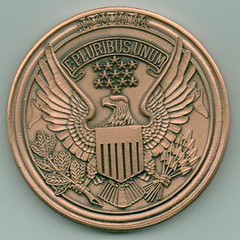
I acquired the attached challenge coin on eBay a few months ago. It was about President Clinton's visit to Viet Nam in November 2000. I barely glanced at the image before making my bid.
My bid was successful and the piece arrived in the mail. When I looked at it, I could not believe that the President's staff would have created such an error. The design on the "visit" side of the piece are of two people from the Philippines and not Viet Nam! I can easily see the smirk on the faces of the Vietnamese receiving this piece and saying, "I am sure we Asians all look alike!"
In the future, I will send the image of the challenge coin from the Marine Guard at the US Embassy in Jakarta, Indonesia. To say the least, this piece has a much better design than the above piece.
INTERVIEW WITH CHRIS WEBB OF DIX NOONAN WEBB
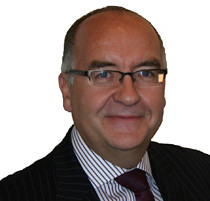 News of record-breaking prices realized for coins
and even banknotes continues to make mainstream headlines. Michael Alexander of the London banknote and Monetary Research Centre speaks to Chris Webb, one third of the well-known
and respected Auctioneers Dix Noonan Webb in London and learns just what’s behind the trends behind such headline-making sales results.
News of record-breaking prices realized for coins
and even banknotes continues to make mainstream headlines. Michael Alexander of the London banknote and Monetary Research Centre speaks to Chris Webb, one third of the well-known
and respected Auctioneers Dix Noonan Webb in London and learns just what’s behind the trends behind such headline-making sales results.
It’s a pleasure speaking to you today, first, for those of our readers who aren’t familiar with Dix Noonan Webb, can you tell them a little bit about the company and what you do, especially as your own name is part of the company’s name, who are the other principals and when was the company formed?
Dix Noonan and Webb was founded by our present managing director Nimrod Dix in 1991, we’re just off Piccadilly in central London. My other partners are Pierce Noonan and Robin Greville. Nimrod and Pierce are military medal experts and Robin is the IT director so, our staff is actually 12 and a half people, and this includes my daughter Danielle who is the half, as she’s a mother and works as a part time photographer and sale clerk. Dix Noonan and Webb also have seven specialist consultants and thirteen agents in this country and around the world. We hold on average four British and world coin sales, one ancient coin sale, four military medal sales and one militaria. In all, about ten thousand lots pass through our offices totaling between 6 to 8 million pounds a year. This year [2010], we anticipate that total increasing by around another million…
What is your specialty at DNW?
I don’t have one really, we’re lucky to have the likes of Peter Preston Morley, Jim Brown, Michael Sharp, Peter Mitchell, Douglas Saville and Italo Vecci who are the real specialists in their field. I enjoy meeting the clients and all the other aspects of auctioneering, so for me, every day is different.
I think there’s a real misconception about auctions with a lot of coin and banknote collectors, insomuch as it’s thought that only the rich, the famous or big institutions can buy items from auctions. Why do you think that is?
You’re right, there is a real misconception about this especially as 95% of our lots are under £1,000 which means we see collectors from every walk of life. If you have a look at our catalogue for this Wednesday’s auction of coins from the late Alfred Bole, (29th September 2010) there’s an excellent selection of coins dating from George III to George V and many of those lots are under £200. In this regard, we cater for most pockets and budgets and the internet in particular has really changed the face of auctions and we ourselves have a database of over 15,000 interested buyers and sellers.
You have plenty of competition not only in London but internationally. Is it important to go to an auction house that has a specialty or is reputation and longevity more important?
That’s true, there are seven coin auctioneers in London alone which might appear to be too many but they all seem to be producing catalogues, they see good numbers attending the sales and are getting the results. I think reputation has everything to do with securing consignments, after all, clients are handing over their valued possessions to us. I think they need to feel comfortable and secure in the knowledge that their entire collection or single item will be handled correctly. You know, next year is our 20th year in business and with almost one hundred sales under our belts and a combined expert knowledge totaling over two hundred years, this I believe speaks for itself!
Can you tell our readers some of the most surprising items which have passed through in terms of realizing a price or rarity?
Oh sure, one of the most unusual coins that passed through our hands was a silver Hogarth three pence coin from Australia. It was brought in to us when we held a valuation day in Dublin in 2003. A rare coin indeed, but what made it so unusual was how it ended up in our hands, the coin was consigned in Dublin, the vendor, or seller was from Chile and it was sold in London and bought by an Australian, the coin had virtually traveled around the world before it found a good home for £9,800!
To read the complete article, see: Interview with Chris Webb of Dix Noonan Webb
(news.coinupdate.com/interview-with-chris-webb
-of-dix-noonan-webb-0708/)
ARTICLE PROFILES PRINCETON CURATOR ALAN STAHL
On a table behind a locked gate in a vault at Princeton University, ancient coins lie sprinkled in their boxes.
Some are copper; some, gold. Some are straight and flat. Others are cupped like tiny saucers. They bear the images of Alexander the Great or the Emperor Augustus or the 7th century emperor, Constans II, because they were minted during the reigns of these rulers thousands of years ago.
The rulers and their empires have long since turned to dust, but their coins are still around. Worn and ragged-edged and of all sizes, they look like what they are -- pieces of history. And they are here, at Princeton, in a collection that has been curated since 1849, the oldest such in the United States.
Professor Alan M. Stahl, curator of numismatics at Princeton and a scholar and author, presides over the collection with the bemused air of someone who has seen it all. While a guest professes astonishment at the weight and feel of a coin from 336 B.C. minted in Macedonia, Stahl chuckles lightly. He does this kind of thing every day, and he uses it not to stoke his own curiosity but to illuminate history.
"It focuses your attention on something that people of the time took for granted. People who wrote in those eras almost never talk about the coins, just like now they might never mention what a dollar bill looks like. But by looking at it seriously and studying it, you see something new about a society," said Stahl. For example, you can learn how long coinages survived and where they circulated, he said. "You find coins from Venice in the Black Sea, and that tells you something.
"Coinage debasement, that tells you a lot -- if you put a lot of silver in your coin and then all of a sudden you cut that silver in half, that tells you about the economy," Stahl said.
"And, of course, the imagery on the coinage is very important too. Often these things aren't recorded. So the important thing is to be able to learn what's going on and then interpret it."
For example, Stahl will use coinage of a more recent provenance to illustrate a little known fact about the formation of the United States. In an exhibition slated to run a year from now, Stahl will feature coins to depict the often intense debate about what or who was to be pictured on our new country's currency.
To read the complete article, see: To discerning eye, ancient silver yields
gold (www.nj.com/news/times/regional/index.ssf?
/base/news-22/1298789130186671.xml&coll=5)
THE BOOK BAZARRE
GADDAFI'S LIBYA BANKNOTE ORDER FOILED BY PRINTER DE LA RUE
As desperate Libyans besiege banks to withdraw their savings Colonel Gaddafi ordered £900million from British banknote printer De La Rue in a last-ditch bid to cobble together cash to fund his dying regime.
The transfer is understood to have been blocked by the Government after the treasury spotted it, with the cash being held at a secure safe house in the north east. A spokesman for De La Rue declined to comment, but the banknote printer is the only British company in a position to print cash on behalf of a foreign power.
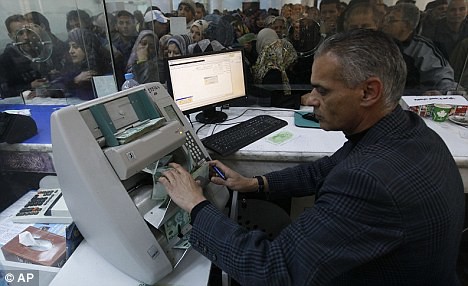
Libyan citizens withdraw cash
To read the complete article, see: Libya's dictator Gaddafi
denied De La Rue deal (www.dailymail.co.uk/money/article-1361605/
Libyas-dictator-Gaddafi-denied-De-La-Rue-deal.html)
THOUGHTS ON THE BRITISH MUSEUM
Bruce Perdue writes:
I found the article about the British Museum to be timely as I was there in March of 2010 and spent a good bit of time there as my children wandered in other areas that interested them. Their "hands on" coins were a delight to be able to hold.
Alan V. Weinberg writes:
The E-Sylum's coverage of the British Museum's numismatic collection took me back to my five day visit in the summer of 1966. I spent the summer in Europe visiting various numismatic collections in museums, among other distractions such as an American nurse touring Europe...but that's another story.
I asked to see the American coins in the museum's vault and without much ado I was permitted to enter their locked vault room. They didn't know me from Joe Smith and I submitted no references. For five days I handled tray after tray of fabulous American coins, all raw, unprotected in tiny little wood insets in shallow wood cabinet trays brought out to me, several at a time. There was no supervision whatsoever. No one checking on you or looking over your shoulder and seeing that you handled specimens correctly. Reminds me of my visit to Evergreen House at JHU in 1967 where curator Sarah Freeman brought me out tray after tray of the Garrett coins and medals...but that too is another story. Anyway, back to the 1966 British Museum.
A partially mint red 1794 half cent. An Uncirculated 1794 dollar. Uncirculated 1787 George Clinton NY colonial coppers, two of them resting on top of each other. Two Very Fine different Higley 3d's. Superb Massachusetts colonial silver coinage including an NE shilling. A superb Unc 1792 half disme - missing - and replaced with a polished EF 1829 half dime.
I brought this last item and a few other notably missing or switched coins to the curator's attention and, I'm told, security tightened up a short period later. The vast majority of superb American early coins, and there were many hundreds of them, had small round tickets with them indicating that prominent world explorer Sir Joseph Banks or his wife Sophie Banks had donated the coins in 1800 to the BM.
Sir Joseph Banks, played by distinguished actor Henry Stephenson, was a prominent figure in the 1935 movie "Mutiny on the Bounty" and was the Franchot Tone character's benefactor in that classic Clark Gable / Chas. Laughton movie.
From the variety of and top quality of coins the Banks donated in 1800, including great rarities that didn't just widely circulate in the US in the 1780's-1790's (like Higleys and Clinton cents) , it was clear to me that Sir Joseph Banks was a serious coin collector in that period and not just a man like the Lord St. Oswald Sir Roland Winn who grabbed up some coins in U.S. circulation and brought them back to England in the 1790's. Indeed, Sir Joseph Banks might be regarded as one of the most prominent numismatists of the world in the past few centuries.
Around 2000 I re-visited the British Museum and was again allowed into the vault rooms without any prior appointment or references, and led into a viewing room where I sat with another collector. And we both were allowed to view rare items, but this time not on a tray level, or handle things raw in hand without someone standing over us.
This time in my case a unique silver hand-engraved George Washington Indian Peace Medal, literally a pristine gem "Proof", given personally to King George III whose estate, I was informed, gave it to the BM in exchange for estate tax relief. I questioned whether Royal estates were taxed, but I was assured that was the case.
There was the old round ticket with the medal ascribing it to George III in, as I recall, 1800 (apparently a very good year for the BM!) , the King who lost the colonies to the Americans. I'm told John Kraljevich had a similar pleasure handling the same medal. Absolutely one of the most extraordinary numismatic items I have ever seen.
MEDALS FOR THE 1897-1898 OVERLAND RELIEF EXPEDITION
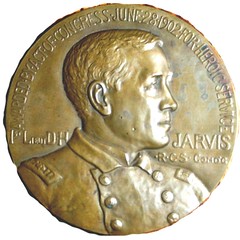

“Be it enacted by the Senate and House of Representatives of the United States of America in Congress assembled, That the Secretary of the Treasury is hereby directed to bestow a gold medal of honor, of such design as he may approve, upon First Lieutenant David H. Jarvis, Second Lieutenant Ellsworth P. Bertholf, and Doctor Samuel J. Call, surgeon, all of the Revenue- Cutter Service and members of the overland expedition of eighteen hundred and ninety-seven and eighteen hundred and ninety-eight for the relief of the whaling fleet in the arctic regions, in recognition of the heroic service rendered by them in connection with said expedition."
Eight whaling ships failed to return to port by November, 1897. These ships were in the Arctic. It was presumed that they had been frozen into the ice. A plea for relief was sent to President McKinley.
The U.S. Revenue Cutter Bear was dispatched, hoping to reach Nome. Weather and slush ice prevented the Bear from doing this. They back tracked and landed at Tununak, opposite Nunivak Island.
Three men volunteered for the overland journey: 1st Lt. David H. Jarvis, 2nd Lt. Ellsworth P. Bertholf and Dr. Samuel J. Call. The plan was to take dog teams to the Seward Peninsula, purchase domestic reindeer from herders and drive them to Barrow.
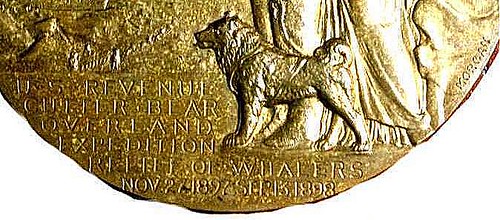
Dick adds:
It would be nice to know how many of these were made so that I could have the appropriate level of non-buyer’s remorse.
NOTES FROM E-SYLUM READERS: MARCH 6, 2011
E-Sylum Images in Gmail
Robert Zavos reported a problem seeing "external images" in The E-Sylum using Gmail in Internet Explorer. He writes:
This only happened with
- Windows7
- IE8 at medium-high security (Firefox and Chrome always worked)
- GMAIL Their first suggested fix didn't work for me. The real fix was to change "Display mixed content" to ENABLE. In case others have this problem, see mail.google.com/support/bin/answer.py?hl=en&answer=8833 .
On Chinese Counterfeit Coins
Bruce Perdue writes:
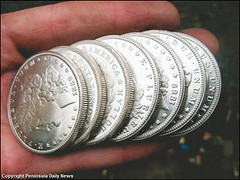 During the Central States
Numismatics Society 72nd Anniversary Convention in Chicago (Rosemont) we have scheduled a seminar on Friday at 4:30PM with three very knowledgeable speakers. I encourage anyone
who will be at the show to attend this program.
During the Central States
Numismatics Society 72nd Anniversary Convention in Chicago (Rosemont) we have scheduled a seminar on Friday at 4:30PM with three very knowledgeable speakers. I encourage anyone
who will be at the show to attend this program.
"Program: Beth Deisher, Steve Roach and Dr. Greg DuBay: The Threat of Counterfeit Coins from China"
The complete schedule of events can be found here - www.centralstates.info/sched.html
To read the earlier E-Sylum article, see: MORE ON CHINESE COUNTERFEITS (www.coinbooks.org/esylum_v14n09a15.html)
On Borders Books
Leon Saryan writes:
The article about Borders is very interesting. Several years ago, I can recall reading an article in the National Review to the effect that Borders stores would actively suppress books on conservative topics or by conservative writers. The political bias of the managers and salespeople was palpable. I am not sad to see them die on the vine.
To read the earlier E-Sylum article, see: BORDERS BANKRUPTCY - WHO GETS STIFFED? (www.coinbooks.org/esylum_v14n09a10.html)
ARTICLE DISCUSSES THAMES RIVER NUMISMATIC FINDS
 It's seven in the morning and we kneel in
black mud on the freezing banks of London's River Thames in the shadow of St Paul's Cathedral, where a church has dominated the ancient city since the 7th century.
It's seven in the morning and we kneel in
black mud on the freezing banks of London's River Thames in the shadow of St Paul's Cathedral, where a church has dominated the ancient city since the 7th century.
As the tide ebbs exposing the shore, Steve Brooker casually tosses a 17th century trader's token he has found in the dirt into his bucket.
"Remember it's all about getting your eye in," says Brooker, who, armed with little more than a trowel, gloves, obligatory boots and an infectious enthusiasm has been combing the foreshore for antiquities for the past 20 years.
Traders' tokens were issued by local merchants during and after the English Civil War (1642-1651) as a form of small change at a time when lower denominations of the realm were out of circulation. Preserved by the oxygen-free mud, the tiny copper-alloy farthing bears the name Thomas Lowe of Three Nuns Alley.
The other side of the coin is stamped with the figures of three nuns and is later traced to a merchant's house in a long-lost narrow lane that now lies buried deep somewhere beneath Threadneedle Street, home to the Bank of England.
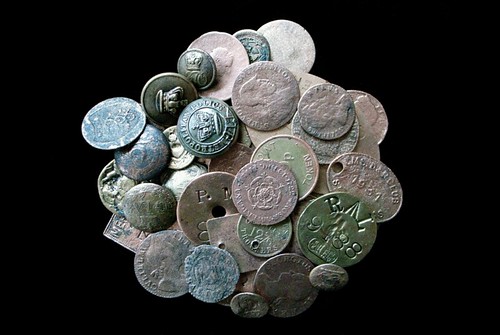
"You can smell the history down here -- it's everywhere," he says as we disappear from view for a guided tour under the cavernous quay supports of Old Billingsgate Fish Market, an ancient place associated with the trade of all manner of goods, including seafood, since medieval times.
Brooker, 49, a larger than life character -- he is 6 feet 6 inches tall -- is no ordinary beachcomber however.
He is one of only 45 members of the Society of Thames Mudlarks who are licensed by the Port of London Authority to search the northern shore between Westminster, the seat of government, in the west of the old city and the Tower of London in the east.
Anyone can walk the length of the capital's exposed shore at low tide but only mudlarks, who diligently record their finds with the museums, can excavate the archaeologically rich north bank. Members of the public can give it a go too, so long as they buy a permit, but they are only allowed to search to a depth of a few inches on the southern shore and, like mudlarks, must report anything over 300 years of age.
Discoveries are returned to the finder once they have been photographed and the find spot revealed.
The Thames has been settled for millennia and the range of items it continues to yield is testament to its rich past. Prehistoric and Celtic tribes as well as Roman, Saxon, Viking and Norman occupiers have all graced its slippery banks and left their indelible mark.
Kate Sumnall, an archaeologist and Finds Liaison Officer with the Museum of London who is charged with identifying mudlark finds says their work is "phenomenally important."
"They have made a huge contribution by donating artefacts to us, but also in terms of the knowledge they bring because they have been showing us their finds for such a long time -- I often learn from them," she told Reuters.
"The medieval toys and pilgrim badges (they have found) are two of the key collections where their contributions have really helped change archaeological interpretation of the past."
Pewter pilgrim badges, 13th century keepsakes gathered by our god-fearing ancestors from religious shrines that dotted the land, are a mudlark's favorite.
Brooker has scooped up thousands of artefacts from the mud over the years, and along with his peers, has recorded many historically important finds with the London and British Museum.
His own collection includes Tudor daggers, opulent 18th century Georgian century shoe buckles, ornate medieval broaches and coins from almost every realm. He has even plucked tiny pairs of perfectly preserved leather shoes from the mud that once belonged to Roman children. Many finds are displayed on his website: http://thamesandfield.com/.
In 2009 he made world headlines when he discovered an iron ball and chain deep in the mud. The leg irons, thought to be 300 years old, still had the lock fastened, suggesting a convict may have drowned while trying to escape its grasp.
Since then he has drawn considerable media interest, and has just finished filming an eight-part series called "Mud Men" for the international satellite channel History, formerly the History Channel which began in Britain on Monday.
In the show, dubbed "guerrilla archaeology" by the makers, a mud-spattered Brooker teams up with British radio presenter and foreshore novice Johnny Vaughan to unravel the story behind every discovery they make.
The unlikely pairing makes for compelling viewing as they explore the quirkier side of English history, sometimes with hilarious results. Experts are on hand to help with identification and give insights into each era.
"It's about educating people about the past and what's out there and getting them involved -- It's archaeology for everyone," says Brooker who eventually wants to open his own foreshore museum close to the river.
To read the complete article, see: For the Past 20 Years London's Society of Mudlarks Retrieve History from the Thames (www.artdaily.org/index.asp?int_sec=2&int_new=45451)
SHROPSHIRE MEDIEVAL COIN FIND DECLARED TREASURE
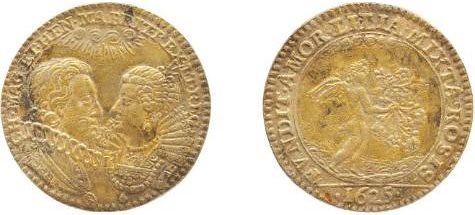
Three hoards of medieval coins found in Shropshire have been declared as treasure by a coroner.
The coins �" dating from the 13th to 17th centuries �" were discovered in Baschurch and near Oswestry.
Mr John Ellery, coroner for north and mid Shropshire, declared all three finds as treasure trove at inquests in Wem yesterday.
The finds could now go on display at Rowley’s House Museum in Shrewsbury and Powysland Museum.
Mr Ellery heard the Baschurch discoveries of 35 medieval pennies were probably linked to a bigger hoard of 190 coins discovered at the same site in the village in 2007 and declared as treasure in 2009.
In his report for the coroner, Dr Barrie Cook, curator of medieval and early modern coinage at the British Museum, said: “That the find-spot of the hoard is so close to Shrewsbury itself, might suggest that this portion might well have remained in the possession of one original owner.”
The inquest heard the coins probably date back to the mid to late-1260s and may go on display at Rowley’s House Museum.
To read the complete article, see: Shropshire medieval coin
finds declared treasure trove (www.shropshirestar.com/news/2011/03/01/
shropshire-medieval-coin-finds-declared-treasure-trove/)
HOW MUCH FORGED MONEY IS IN CIRCULATION IN THE UK?
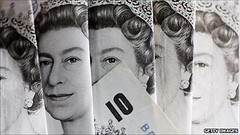 The history of counterfeit money is
almost as old as currency itself, and despite the use of the most sophisticated modern technology, the battle persists today between the banks and the fraudsters.
The history of counterfeit money is
almost as old as currency itself, and despite the use of the most sophisticated modern technology, the battle persists today between the banks and the fraudsters.
It is not difficult to see the watermark, hologram and metal thread inside banknotes.
But visit De La Rue, the company that prints banknotes for the UK and 150 other countries and you will discover a wealth of other, hidden security features.
Whereas most graphic print uses just one printing process, sterling banknotes are made with three.
Run your fingernail across the number ten in the top right corner, and you'll feel how bumpy the surface is. The tactile intaglio print deposits the ink in recesses in the paper surface also giving the banknote its crisp, shiny quality.
"It's a high pressure printing process so where there's no type you get a smoothing of the paper, which also means the note doesn't accept dirt so easily," says Paul Howland, head of paper science at De La Rue.
Behind Darwin's head, the pastel blues, greens and oranges are not made up of dots of colour, like most graphics, but instead are made up of tiny lines as a result of the offset printing technique used.
There is also microprint hidden inside the images. A magnifying glass will reveal the word "ten" printed inside the Queen's pearls.
But at London's Church Street market, stallholders still have to keep their eyes peeled for fakes.
"You get spates of them, every now and again," a fruit and veg seller said. "Everyone will get one or two."
Skimming the top edge of the intaglio print will often tell stallholders whether the note is a fake, but some even pass this test: "If you saw the last lot we had, they were perfect. You couldn't tell by looking at them," he said.
In 2009, Bank of England figures revealed 566,000 counterfeit notes in the UK. Of these, 95% were twenty pound notes.
To read the complete article, see: How much forged money is in circulation in the UK? (www.bbc.co.uk/news/business-12578952)
BRITISH STUDENT DESIGNS 2011 NETHERLANDS TWO EURO COIN
 Four million two-Euro coins have been produced
bearing an image created by a Northumbria University student.
Four million two-Euro coins have been produced
bearing an image created by a Northumbria University student.
Dylan Shields, a final year BA (Hons) Fine Arts student, won a European-wide competition to design an official commemorative two-Euro coin after visiting Holland as part of an Erasmus exchange.
The 27-year-old, who creates detailed sculptures using cardboard and sticky tape, entered the competition with his sculptural reinterpretation of the artist Hans Holbein’s portrait of Desiderius Erasmus, the great Dutch humanist and writer of The Praise of Folly �" one of the most influential works of western civilisation.
Dylan then created a scan of the sculpture using a rapid prototype printer, provided by Northumbria’s School of the Built and Natural Environment and entered it into the competition.
Dylan’s concept was chosen from among 60 European artists who were asked to enter the contest, part of the European Commission’s celebration of the tenth anniversary of the Euro and European Monetary Union.
He was invited to give a presentation about his entry, and after impressing the competition judges, Dylan reached the final stage, where his work was assessed alongside that of two other finalists.
The Dutch Minister of Finance and the competition commission chose Dylan’s work as the winning design, which has now been made into the official commemorative two-Euro coin. The Royal Dutch Mint has now produced four million units of the coin.
Dylan flew to Holland this week to be presented with the first coin to be minted with his design as well as a cash prize.
To read the complete article, see: British student coins new Euro
(www.creativeboom.co.uk/north-east/news/
british-student-coins-new-euro/)
DICKIN MEDAL PROPOSED FOR TALIBAN-FIGHTING DOG THEO
 In life, they were inseparable.
And in death, this brave man and his best friend are staying by each other’s side.
In life, they were inseparable.
And in death, this brave man and his best friend are staying by each other’s side.
A record-breaking Army sniffer dog and his devoted handler will make their final journey home together next week.
Theo, a springer spaniel cross, suffered a fatal seizure shortly after his master, Lance Corporal Liam Tasker, was shot dead by the Taliban on Tuesday.
The 22-month-old dog was said to have died of a broken heart after the Arms and Explosives Search soldier was killed.
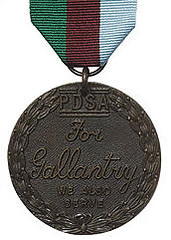 The pair had uncovered 14 home-made bombs
and hoards of weapons in just five months on the frontline �" more than any other dog and handler in the conflict. And when L/Cpl Tasker, 26, is repatriated to RAF Lyneham in
Wiltshire next week, Theo’s ashes will be alongside his body in a casket on the RAF Hercules carrying the coffin.
The pair had uncovered 14 home-made bombs
and hoards of weapons in just five months on the frontline �" more than any other dog and handler in the conflict. And when L/Cpl Tasker, 26, is repatriated to RAF Lyneham in
Wiltshire next week, Theo’s ashes will be alongside his body in a casket on the RAF Hercules carrying the coffin.
A campaign has also been launched to award Theo a Dickin Medal �" the animal equivalent of the Victoria Cross.
To read the complete article, see: Their last journey:
Tragic bomb dog Theo in line for an 'animal VC' as he and his master's body are flown home together (www.dailymail.co.uk/news/article-1362837/Bomb-sniffing
-Army-dog-master-repatriated-Wootton-Bassett.html)
To read a related article, see: TALIBAN IS TARGETING OUR BRAVE DOGS OF WAR
(www.express.co.uk/posts/view/232844/Taliban-is-
targeting-our-brave-dogs-of-war)
VIDEO: VANCOUVER 2010 WINTER OLYMPICS MEDAL DISPLAY
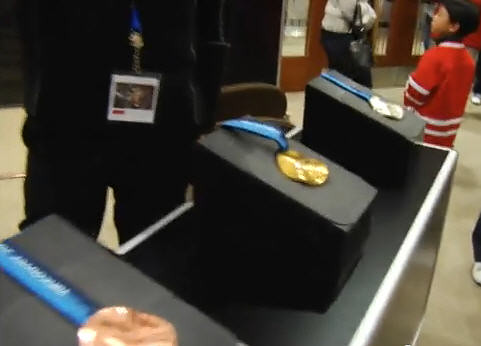
To watch the YouTube video, see: Vancouver 2010 Winter Olympics - Medal Display - The Royal Canadian Mint (www.youtube.com/watch?v=GsvXmdItR-k)
FEATURED WEB PAGE: A HAND-ENGRAVED GOLD DOLLAR PATTERN
This week's Featured Web Page is from the Heritage web site, featuring a hand-engraved gold dollar pattern. Lot 4362 in the firm's upcoming March 2011 sale, the coin was highlighted as a "Seldom Seen Selection" in the Heritage email newsletter this week. Interesting coin!
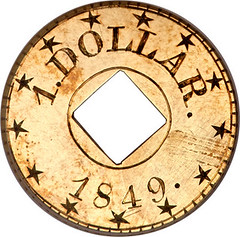

1849 Gold Dollar With Square Perforation
Judd-115, PR60, Hand-Engraved by James Longacre
1849 PG$1 Gold Dollar, Judd-115, Pollock-130, High R.7, PR60 PCGS. A simply laid-out coin that has a square central perforation. On the obverse, around the perforation, is the legend 1.DOLLAR. 1849. The reverse has a laurel wreath around the perforated center and outside that UNITED STATES OF AMERICA. Struck in gold with a plain edge.
These are fascinating patterns. The devices were hand-engraved (not struck) by James Longacre, which gives each piece an individuality. According to the Judd reference, the fineness of these pieces ranges from 50% to 100%.
coins.ha.com/common/view_item.php?
Sale_No=1153&Lot_No=4362
